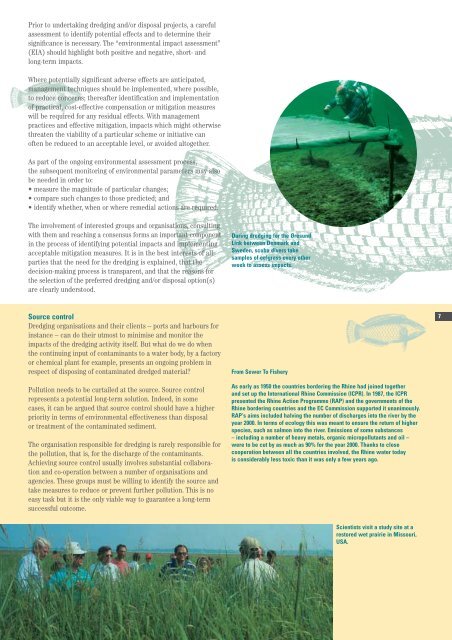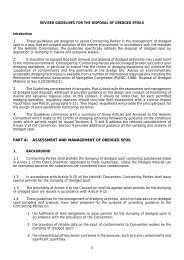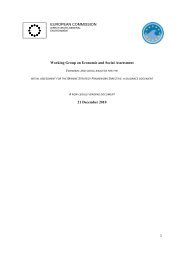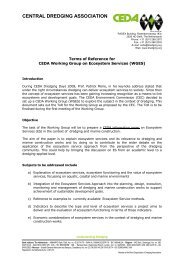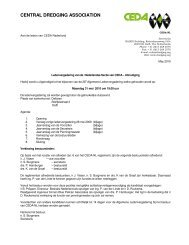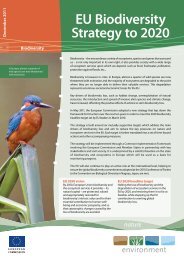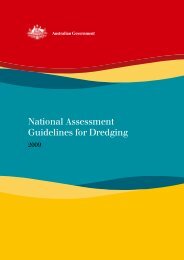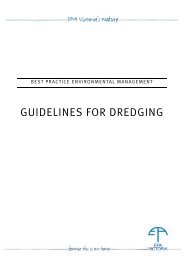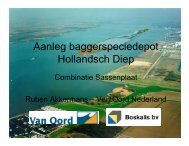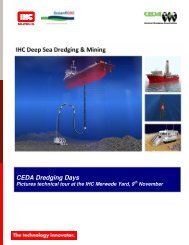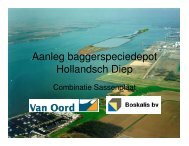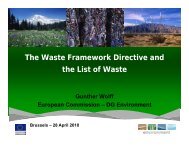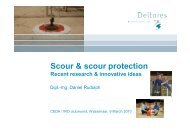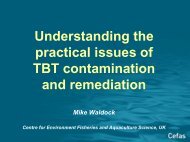dredging: the facts - Central Dredging Association
dredging: the facts - Central Dredging Association
dredging: the facts - Central Dredging Association
Create successful ePaper yourself
Turn your PDF publications into a flip-book with our unique Google optimized e-Paper software.
Prior to undertaking <strong>dredging</strong> and/or disposal projects, a carefulassessment to identify potential effects and to determine <strong>the</strong>irsignificance is necessary. The “environmental impact assessment”(EIA) should highlight both positive and negative, short- andlong-term impacts.Where potentially significant adverse effects are anticipated,management techniques should be implemented, where possible,to reduce concerns; <strong>the</strong>reafter identification and implementationof practical, cost-effective compensation or mitigation measureswill be required for any residual effects. With managementpractices and effective mitigation, impacts which might o<strong>the</strong>rwisethreaten <strong>the</strong> viability of a particular scheme or initiative canoften be reduced to an acceptable level, or avoided altoge<strong>the</strong>r.As part of <strong>the</strong> ongoing environmental assessment process,<strong>the</strong> subsequent monitoring of environmental parameters may alsobe needed in order to:• measure <strong>the</strong> magnitude of particular changes;• compare such changes to those predicted; and• identify whe<strong>the</strong>r, when or where remedial actions are required.The involvement of interested groups and organisations, consultingwith <strong>the</strong>m and reaching a consensus forms an important componentin <strong>the</strong> process of identifying potential impacts and implementingacceptable mitigation measures. It is in <strong>the</strong> best interests of allparties that <strong>the</strong> need for <strong>the</strong> <strong>dredging</strong> is explained, that <strong>the</strong>decision-making process is transparent, and that <strong>the</strong> reasons for<strong>the</strong> selection of <strong>the</strong> preferred <strong>dredging</strong> and/or disposal option(s)are clearly understood.During <strong>dredging</strong> for <strong>the</strong> ØresundLink between Denmark andSweden, scuba divers takesamples of eelgrass every o<strong>the</strong>rweek to assess impacts.Source control<strong>Dredging</strong> organisations and <strong>the</strong>ir clients – ports and harbours forinstance – can do <strong>the</strong>ir utmost to minimise and monitor <strong>the</strong>impacts of <strong>the</strong> <strong>dredging</strong> activity itself. But what do we do when<strong>the</strong> continuing input of contaminants to a water body, by a factoryor chemical plant for example, presents an ongoing problem inrespect of disposing of contaminated dredged material?Pollution needs to be curtailed at <strong>the</strong> source. Source controlrepresents a potential long-term solution. Indeed, in somecases, it can be argued that source control should have a higherpriority in terms of environmental effectiveness than disposalor treatment of <strong>the</strong> contaminated sediment.The organisation responsible for <strong>dredging</strong> is rarely responsible for<strong>the</strong> pollution, that is, for <strong>the</strong> discharge of <strong>the</strong> contaminants.Achieving source control usually involves substantial collaborationand co-operation between a number of organisations andagencies. These groups must be willing to identify <strong>the</strong> source andtake measures to reduce or prevent fur<strong>the</strong>r pollution. This is noeasy task but it is <strong>the</strong> only viable way to guarantee a long-termsuccessful outcome.From Sewer To FisheryAs early as 1950 <strong>the</strong> countries bordering <strong>the</strong> Rhine had joined toge<strong>the</strong>rand set up <strong>the</strong> International Rhine Commission (ICPR). In 1987, <strong>the</strong> ICPRpresented <strong>the</strong> Rhine Action Programme (RAP) and <strong>the</strong> governments of <strong>the</strong>Rhine bordering countries and <strong>the</strong> EC Commission supported it unanimously.RAP‘s aims included halving <strong>the</strong> number of discharges into <strong>the</strong> river by <strong>the</strong>year 2000. In terms of ecology this was meant to ensure <strong>the</strong> return of higherspecies, such as salmon into <strong>the</strong> river. Emissions of some substances– including a number of heavy metals, organic micropollutants and oil –were to be cut by as much as 90% for <strong>the</strong> year 2000. Thanks to closecooperation between all <strong>the</strong> countries involved, <strong>the</strong> Rhine water todayis considerably less toxic than it was only a few years ago.7Scientists visit a study site at arestored wet prairie in Missouri,USA.


